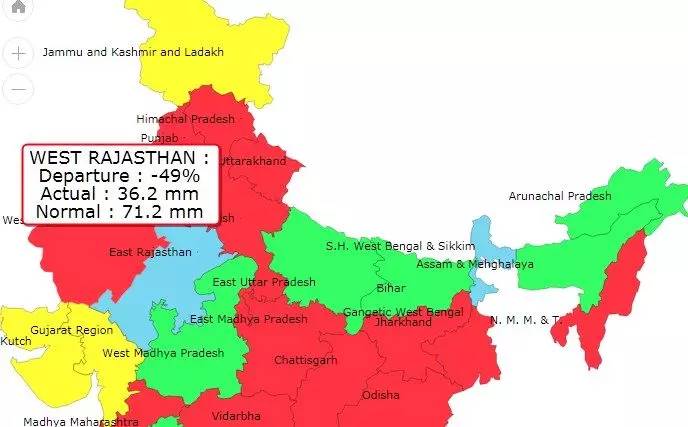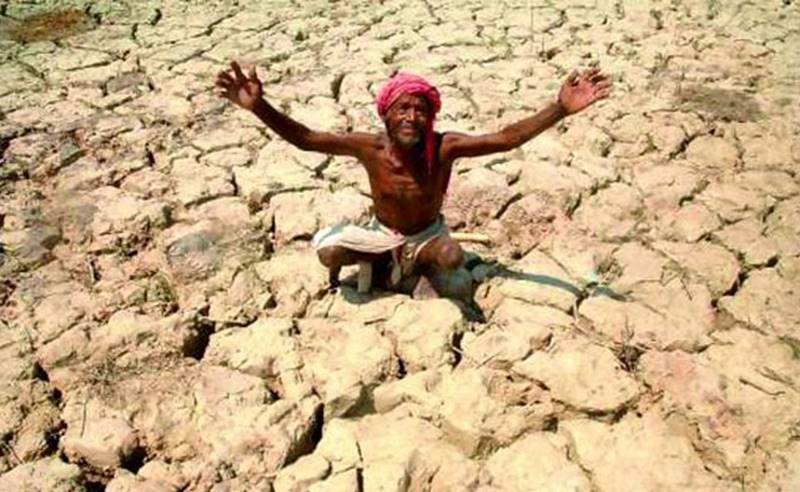Withered crops, cattle in distress; west Rajasthan stares a drought in the face as monsoon rains play truant
While traditionally this is a rain-starved arid area, farmers and cattle rearers are in grief as even the sparse rain they should have received has evaded them in the districts of Barmer and Jaisalmer.


Rajasthan is not unfamiliar with droughts. Since Independence, barring a handful of years, the state has faced droughts almost every year. Photo: Creative Commons
Jaisalmer, Rajasthan
It’s been over five weeks and Jaisalmer and Bikaner districts of western Rajasthan have not received a drop of rain. It is a desert region known for scanty rainfall. However, this monsoon season even the little rainfall the area receives has been missing, triggering a fear of acute drought and distress in the state.
“Droughts were here much before we were born, and it will live on much after we die,” Bhairu Singh, an 82-year-old from Sultana village in Jaisalmer, told Gaon Connection. “It is our destiny. I remember hearing about the frightening drought referred to as chapniya akaal [1899-1900]. That was the time people cooked and ate the bark of trees and any sparse vegetation they could find around them. The drought we are living through now reminds me of that one,” Bhairu Singh said.
Also Read: ‘Green’ energy projects threaten to wipe off ancient ‘orans’ in Jaisalmer, Rajasthan
According to the local farmers, there was rainfall just once or twice in Jaisalmer last month in July after which it has been a dry month. Those farmers who thought the July rains were a good sign and decided to sow crops, are in despair. Their crops are all dead or dying. Even where there were some means of irrigation, the situation is bad, villagers worried.

“The crops are destroyed. And, the cattle have no fodder or water at all. Our water requirements are met by the Indira Gandhi Canal, but we cannot depend on that entirely as the water from there is also not regular or continuous,” Bhairu Singh said.
Deficient rains in western Rajasthan, normal in eastern Rajasthan
The India Meteorological Department (IMD) divides the state of Rajasthan into two meteorological subdivisions — west and east Rajasthan. West Rajasthan is made up of 13 districts including Jaisalmer, Jodhpur, Barmer and Bikaner. Some of these districts border Pakistan and others the state of Gujarat.
Also Read: The desert coolers of Rajasthan
As per the IMD’s rainfall data, this month between August 1 and August 25, west Rajasthan has recorded a rainfall departure of minus 51 per cent, whereas east Rajasthan has had 19 per cent normal rainfall.
In the entire monsoon season so far, which started from June 1, against its normal rainfall of 213.5 mm rainfall, west Rajasthan has received only 167.7 mm rainfall till August 25. Meanwhile, east Rajasthan has received 477.2 mm rainfall which is its normal rainfall.

Deficient rainfall has triggered fear of drought in the western region of the desert state. In the kharif season, farmers in west Rajasthan grow mung beans, kidney beans, cluster beans, millets and groundnuts. But this year the farmers have faced immense losses due to no rains.
Also Read: Large-scale deficient monsoon rainfall across Odisha triggers fear of drought
Explaining the reason behind deficient rainfall in west Rajasthan, DS Pai, chief scientist, climate division of IMD, said: “This area is traditionally dry with less precipitation, and this year the low pressure system did not reach Gujarat and western Rajasthan leading to even less rain.” The low pressure system brought plenty of rain to eastern Rajasthan and west Uttar Pradesh, but did not extend to west Rajasthan, the scientist told Gaon Connection. “While Gujarat saw good rains in the last few years, this year it has been a lot less than usual,” he added.
Withered crops
About 300 kilometers away from Jaisalmer is Bikaner district of Rajasthan, where Ashu Ram Godara, an inhabitant of Palana village, is in grief. “When it rained a little in July, we sowed millets in our fields but they have all withered away,” the 40-year-old farmer lamented.
“I am growing groundnuts in approximately thirteen acres, but I know I will not get even one fourth of the yield,” Godara said.

The July rains gave hope to farmers across Bikaner and Jaisalmer and they sowed seeds, but in vain. According to the farmers in that region it cost them up to Rs 2500 an acre to sow their lands. But all that went to nothing as most of the crops have dried up.
Also Read: The tihaiya farmers of Vindhya region caught in a cycle of debt and destitution
“This year, the rainfall in Barmer has been less than what it should be,” Pradeep Pagaria, agricultural scientist Krishi Vigyan Kendra, Gudamalani, Barmer, told Gaon Connection. The IMD’s rainfall data shows that as against a normal monsoon rainfall of 199.8 mm (June 1-August 25), the district has received only 93.8 mm rainfall, thus registering minus 53 per cent deficient rainfall.
The month of August has been particularly bad as Barmer has received only 12 mm rainfall against its normal of 77.2 mm rainfall. The neighbouring Jaisalmer district has also reported minus 89 per cent rainfall departure between August 1 and August 25.
“Farming in this area is rain-dependent and the bajra [millet] should be sown before July 15. But now there is no hope for the bajra or even other crops,” the agriculture scientist Pagaria said.
Even the drought resistant cluster beans and millets that grow without too much water and are perfectly suited to the arid climes of Barmer in Rajasthan are wilting.
Cattle in distress
Rajasthan is not unfamiliar with droughts. Since Independence, barring a handful of years, the state has faced droughts almost every year. Many cattle rearers migrate to places where they can find fodder for their cattle while others live a life of great struggle. In many parts of the state, camels and donkeys cart water from great distances.
Western Rajasthan is predominantly a region of agriculture and cattle rearing. “The foremost occupation is farming and the next biggest occupation is cattle rearing. Then there is tourism. There is no other industry or source of income in these parts,” Sang Singh Bhati, former MLA from Jaisalmer, told Gaon Connection. “But everything has come to a halt in the drought situation here,” he added.

The cattle are bearing the brunt of the drought too. “The rains have failed us and if we continue to have no rain, even the grass and scrub will disappear leaving our cattle with nothing to eat,” Vikram Singh Tanwar, a cattle rearer from Jaisalmer, told Gaon Connection.
Also Read: Rajasthan: Camels and sheep to face a fodder crisis as about 600-year-old Oran is being uprooted
“We anticipated rains and owed our crops when there was the first couple of rains, but that did not happen. If the rains do not come as they should in September, whatever little we have grown will die,” Magh Singh, a 28-year old farmer from Barmer, told Gaon Connection.
Read the story in Hindi

